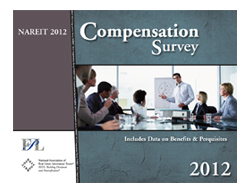|
July 16, 2012
Message from the President
 In our last issue, NewsBrief focused on the approaches our Investor Outreach team is using to communicate the REIT investment proposition to the defined benefit retirement plan marketplace. This week, we review how we are taking the REIT story to the defined contribution plan market. In our last issue, NewsBrief focused on the approaches our Investor Outreach team is using to communicate the REIT investment proposition to the defined benefit retirement plan marketplace. This week, we review how we are taking the REIT story to the defined contribution plan market.
Our internal and sponsored research program is as important in reaching out to the defined contribution market as it is in the defined benefit market. NAREIT has used its research to open doors and build relationships with investment decision-makers at defined contribution product providers, consultants and plan sponsors.
An important focus of our effort is to communicate the benefits of REIT investment to providers of target date and other asset allocation funds. Importantly, because of federal guidelines, these funds are expected to account for the bulk of assets invested in defined contribution plans within the next several years. In the first half of this year, Investor Outreach staff members met with managers that collectively account for more than 85 percent of assets in the target date fund market.
We are seeing significant increases in both the number of asset allocation funds that include REITs and the sizes of REIT allocations in these funds. A survey conducted last year by the consulting firm Callan Associates showed that 73 percent of 33 target date fund series included a real estate allocation which, in the vast majority of cases, was a REIT allocation. Additionally, some of the largest asset allocation fund providers, such as J.P. Morgan, PIMCO, UBS and Alliance Bernstein, are using maximum REIT allocations ranging from 10 to 18 percent.
NAREIT will continue to actively take the REIT story to this marketplace. Next week, we will review our strategy for taking our industrys story to the final segment of the retirement plan marketplace the individual retirement account market.

Steven A. Wechsler
President and CEO
FASB Pulls Plug on Disclosure of Certain Loss Contingencies Project
 On July 9, the Financial Accounting Standards Board (FASB) ceased working on the Disclosure of Certain Loss Contingencies Project when a majority of board members voted to remove the project from its agenda. On July 9, the Financial Accounting Standards Board (FASB) ceased working on the Disclosure of Certain Loss Contingencies Project when a majority of board members voted to remove the project from its agenda.
The FASB issued exposure drafts in 2008 and 2010 that would have increased the amount of loss contingencies disclosures, primarily in the area of litigation. NAREIT expressed strong concerns that the proposals would have required companies to disclose prejudicial information in its August 2008 and September 2010 letters to the board.
NAREIT understands that the board may consider improvements to loss contingencies disclosures in conjunction with the Disclosure Framework Project.
(Contact: Christopher Drula at cdrula@nareit.com)
CFTC Ruling Exempts Certain End-Users from Derivatives Clearing Requirements
 The Commodity Futures Trading Commission (CFTC) last week finalized a rule that ensures certain end-users will be exempt from new derivatives clearing requirements. The Commodity Futures Trading Commission (CFTC) last week finalized a rule that ensures certain end-users will be exempt from new derivatives clearing requirements.
NAREIT and its partners in the Coalition for Derivatives End-Users applauded the ruling, but noted that it will continue to work on issues related to the regulations stemming from the Dodd-Frank Act particularly those rules that would undermine the exemption provided by the CFTC by subjecting end-users to margin requirements on non-cleared transactions.
The coalition is committed to working with regulators and both parties in Congress to ensure that the final end-user exception rule works in practice and is not diluted by burdensome margin or inter-affiliate trade requirements or qualification standards that would harm end-users, who use derivatives to manage risk, not create it, the group said in a statement.
(Contact: Kirk Freeman at kfreeman@nareit.com)
REIT.com Videos: Executive Perspectives
REIT.com interviewed 70 industry professionals during REITWeek 2012 last month. Below are highlights of some of the interviews conducted with leading real estate executives. Be sure to visit REIT.com in the coming weeks as new videos will be added regularly.
 The hotel sector is in great shape, according to Mike Barnello, president and CEO of LaSalle Hotel Properties (NYSE: LHO). After suffering during the downturn of 2008 and 2009, Barnello said demand for the hotel industry started to make a comeback in 2010 and 2011, and it is continuing into 2012. The hotel sector is in great shape, according to Mike Barnello, president and CEO of LaSalle Hotel Properties (NYSE: LHO). After suffering during the downturn of 2008 and 2009, Barnello said demand for the hotel industry started to make a comeback in 2010 and 2011, and it is continuing into 2012.
Supply was much lower in 2011, and it is really low in 2012, he said. And with the combination of low supply and increased demand, its a very health story for the lodging industry.
 Joseph Coradino, the new CEO of Pennsylvania Real Estate Investment Trust (NYSE: PEI), has his eye on reducing the REIT's leverage. "We are focusing on the reduction of leverage below 60 percent," he said. Other goals include bolstering the REIT's operational performance and increasing inline occupancy to more than 90 percent. Joseph Coradino, the new CEO of Pennsylvania Real Estate Investment Trust (NYSE: PEI), has his eye on reducing the REIT's leverage. "We are focusing on the reduction of leverage below 60 percent," he said. Other goals include bolstering the REIT's operational performance and increasing inline occupancy to more than 90 percent.
 Peter Mitchell, CEO of the Asia Pacific Real Estate Association (APREA), said the IPO pipeline is continuing to build for Asian real estate companies, and eventually will lead to more companies going public. In Japan, for example, the first REIT was listed in 2007 an event Mitchell described as a landmark. Singapore is another market with potential for listings, according to Mitchell. Peter Mitchell, CEO of the Asia Pacific Real Estate Association (APREA), said the IPO pipeline is continuing to build for Asian real estate companies, and eventually will lead to more companies going public. In Japan, for example, the first REIT was listed in 2007 an event Mitchell described as a landmark. Singapore is another market with potential for listings, according to Mitchell.
Looking ahead, Mitchell said new REIT markets should continue to emerge in the second half of 2012. Thailand now has what I would suggest is a true REIT law, he noted. A REIT act has been passed in the Philippines as well, according to Mitchell, but it is currently on hold as policy regulations are addressed. Mitchell also said he foresees the two big elephants in the room, India and China, will eventually develop REIT regimes of their own.
 American Residential Properties Inc. has been able to capitalize on the housing market crash by investing in for-rent single-family homes and providing short-term private residential mortgage financing, according to company executives Stephen Schmitz, CEO, and Laurie Hawkes, president. The private REIT was formed three-and-a-half years ago after the real estate downturn when Schmitz said there was a huge diminution in property values in residential real estate. American Residential Properties Inc. has been able to capitalize on the housing market crash by investing in for-rent single-family homes and providing short-term private residential mortgage financing, according to company executives Stephen Schmitz, CEO, and Laurie Hawkes, president. The private REIT was formed three-and-a-half years ago after the real estate downturn when Schmitz said there was a huge diminution in property values in residential real estate.
We also saw greater availability of product coming through foreclosures or short sales. But, more importantly, what we saw was the new American tenant, those people who went through foreclosures and short sales, he said.
Its that tenant that really led us to start our company.
 American Realty Capital Properties' (NASDAQ: ARCP) retail tenants are generating stable sales and strong earnings, said Chairman and CEO Nicholas Schorsch. "Balance sheets are getting stronger," Schorsch said in reference to American Realty Capital Properties' retail tenants. "And the United States is clearly the shining star on a global basis." American Realty Capital Properties' (NASDAQ: ARCP) retail tenants are generating stable sales and strong earnings, said Chairman and CEO Nicholas Schorsch. "Balance sheets are getting stronger," Schorsch said in reference to American Realty Capital Properties' retail tenants. "And the United States is clearly the shining star on a global basis."
 Asia is still posting strong industrial activity, said Jeff Schwartz, deputy chairman of Singapore-based industrial REIT Global Logistic Properties (SGX: MCO.SI). If you dont read the Financial Times, things are great, because the actual business operations are very, very strong, Schwartz said, pointing to Chinas GDP growth of approximately 8 percent and retail sales that are up 14 percent. Asia is still posting strong industrial activity, said Jeff Schwartz, deputy chairman of Singapore-based industrial REIT Global Logistic Properties (SGX: MCO.SI). If you dont read the Financial Times, things are great, because the actual business operations are very, very strong, Schwartz said, pointing to Chinas GDP growth of approximately 8 percent and retail sales that are up 14 percent.
Schwartz said Global Logistic Properties has made a concerted effort to focus on servicing domestic consumption, which accounts for 80 percent of the companys portfolio and will be the primary focus of any development projects that the company takes on this year. He noted that Global Logistics domestic consumption space is leased at a rate of 96 percent.
(Contact: Matt Bechard at mbechard@nareit.com)
NAREIT Comments on Proposed Regulations for Certain Transfers of Property
 NAREIT last week issued comments to the IRS and Treasury Department regarding proposed regulations for certain transfers of property to regulated investment companies (RICs) and REITs. NAREIT last week issued comments to the IRS and Treasury Department regarding proposed regulations for certain transfers of property to regulated investment companies (RICs) and REITs.
Final regulations issued under section 337(d) in 2003 generally provide that when a REIT disposes of appreciated property within 10 years after acquisition from a C corporation in a conversion transaction, the REIT must apply the rules of section 1374 and pay tax at the corporate level on any built-in gain except to the extent that the C corporation either recognizes gain on the transaction or elects deemed sale treatment to recognize and pay tax on the gain from the transaction.
The 2012 proposed regulations would modify the 2003 regulations to exclude two types of conversion transactions from the 2003 deemed sale rule. First, the 2012 proposed regulations would exclude a tax-exempt entity from the definition of a C corporation to the extent it would not be subject to tax on gain on the sale of the transferred property. Thus, a transfer of appreciated property from a tax-exempt entity to a REIT generally would not be a conversion transaction. Second, the 2012 proposed regulations would exclude from the application of the 2003 deemed sale rule a conversion transaction to the extent that the C corporations gain is not recognized by reason of section 1031 or 1033.
In its comment letter, NAREIT recommended that when finalized, the 2012 proposed regulations clarify that, as further described below, a tax-exempt entity is excluded from the definition of a C corporation to the extent that it would not be subject to gain if it were to make a deemed sale election (not merely if it would be subject to any gain on such sale, however insignificant that gain might be). Further, recognizing that both simultaneous and deferred section 1031 exchanges are section 1031(a) exchanges, NAREIT suggests that, when finalized, the 2012 proposed regulations clarify, by way of an example, that reverse section 1031 exchanges are excluded from the 2003 deemed sale rule. Finally, NAREIT recommends that the preamble to the final regulations be clarified so that, for purposes of defining conversion transaction, the term transfer in the final regulations not include the acquisition of appreciated property from a C corporation by a REIT if, immediately after acquisition, the REITs basis is equal to the amount paid for the property (e.g., a sale by the C corporation for cash to the REIT) other than a transaction falling under the gift sale rules. As a result, the disposition of appreciated property by a REIT within 10 years of its acquisition from a C corporation for cash or other consideration paid in an arms length transaction would not be subject to the 2003 deemed sale rule.
(Contact: Dara Bernstein at dbernstein@nareit.com)
REIT.com Videos: Industry Insights
REIT.com interviewed 70 industry professionals during REITWeek 2012 last month. Below are insights from some of the interviews conducted with leading industry observers. Be sure to visit REIT.com in the coming weeks as new videos will be added regularly.
 Cap rates have fallen lower than most analysts predicted, according to Paul Curbo, portfolio manager with Invesco. He points to cap rates for multifamily properties where data say cap rates are in the 5 percent range. However, in some cases they are actually below 4 percent. Cap rates have fallen lower than most analysts predicted, according to Paul Curbo, portfolio manager with Invesco. He points to cap rates for multifamily properties where data say cap rates are in the 5 percent range. However, in some cases they are actually below 4 percent.
We think its a tremendous amount of value creation that analysts are not really including in their estimates, because they are using cap rates that are a little bit higher than where we are today, he said.
 Access to capital, valuations and timing are among the chief reasons why the mergers-and-acquisitions activity in the commercial real estate market has fallen short of expectations, according to Arthur Hurley, vice president and senior portfolio manager with Columbia Management. Access to capital, valuations and timing are among the chief reasons why the mergers-and-acquisitions activity in the commercial real estate market has fallen short of expectations, according to Arthur Hurley, vice president and senior portfolio manager with Columbia Management.
For M&A transactions to take place, you need willing sellers and you need motivated buyers coming together in some pretty complex deals at the same time, and it really takes time for those things to take place, he said. Hurley pointed out that while the transactions market has remained subdued, he does think deal-making will eventually gain steam.
 The outlook for office REITs in the near term remains concerning, according to Michael Knott, managing director with Green Street Advisors. Knott said that while the sector has seen average growth in net operating income (NOI), capital expenditure requirements have been above average and cap rates have been below average. The outlook for office REITs in the near term remains concerning, according to Michael Knott, managing director with Green Street Advisors. Knott said that while the sector has seen average growth in net operating income (NOI), capital expenditure requirements have been above average and cap rates have been below average.
To us, thats an unappealing mix, Knott said. Knott did point out that hes more bullish on markets with high barriers to entry, as opposed to more plain vanilla suburban markets. We feel like the long-run rent growth on an after cap-ex basis has been much stronger, and that has helped deliver strong returns. We feel like that will continue to be the case in the future.
 Look for mall REITs to continue to outperform in the second half of 2012, according to Anthony Paolone, REIT analyst with J.P. Morgan. In the mall group, you still have positive rent spreads, Paolone said. Most of the companies in the mall space own high-quality centers that are very productive and have pretty good pricing power now over tenants. Thats a space where we see continued growth. Look for mall REITs to continue to outperform in the second half of 2012, according to Anthony Paolone, REIT analyst with J.P. Morgan. In the mall group, you still have positive rent spreads, Paolone said. Most of the companies in the mall space own high-quality centers that are very productive and have pretty good pricing power now over tenants. Thats a space where we see continued growth.
(Contact: Matt Bechard at mbechard@nareit.com)
2012 Compensation Survey Now Available
 The 2012 NAREIT Compensation Survey features responses from 113 REITs and real estate companies. NAREIT and FPL have been able to compile detailed compensation information for 108 positions, resulting in the largest, most comprehensive survey to date. The 2012 NAREIT Compensation Survey features responses from 113 REITs and real estate companies. NAREIT and FPL have been able to compile detailed compensation information for 108 positions, resulting in the largest, most comprehensive survey to date.
For more than 18 years, NAREIT has been providing members and the real estate industry at large with valued information on compensation for REITs and real estate companies. In particular, this report provides information for three major facets of compensation:
-
Base salary (2012)
-
Annual incentive award value (for calendar/fiscal year 2011 and typically paid in 2012
-
Long-term incentive award value (for calendar/fiscal year 2011 and commonly granted/awarded in 2012)
Segment comparisons are available for all positions including property sector, total capitalization, and the number of full-time employees. The report also provides informative data on organizational structure and general company and financial information across all respondents.
On an aggregate basis, the 95 participating publicly traded companies represent approximately $617 billion in total capitalization, which is approximately 80 percent of the total capitalization in the publicly traded, U.S. REIT industry, truly making this survey the most comprehensive of its kind.
NAREIT Corporate Members who participated in the survey can purchase additional copies at a significant discount.
(Contact: Megan Peichel at mpeichel@nareit.com)
|

 In our last issue, NewsBrief focused on the approaches our Investor Outreach team is using to communicate the REIT investment proposition to the defined benefit retirement plan marketplace. This week, we review how we are taking the REIT story to the defined contribution plan market.
In our last issue, NewsBrief focused on the approaches our Investor Outreach team is using to communicate the REIT investment proposition to the defined benefit retirement plan marketplace. This week, we review how we are taking the REIT story to the defined contribution plan market.
 On July 9, the Financial Accounting Standards Board (FASB) ceased working on the
On July 9, the Financial Accounting Standards Board (FASB) ceased working on the  The Commodity Futures Trading Commission (CFTC) last week finalized a rule that ensures certain end-users will be exempt from new derivatives clearing requirements.
The Commodity Futures Trading Commission (CFTC) last week finalized a rule that ensures certain end-users will be exempt from new derivatives clearing requirements.





 NAREIT last week
NAREIT last week 



 The
The